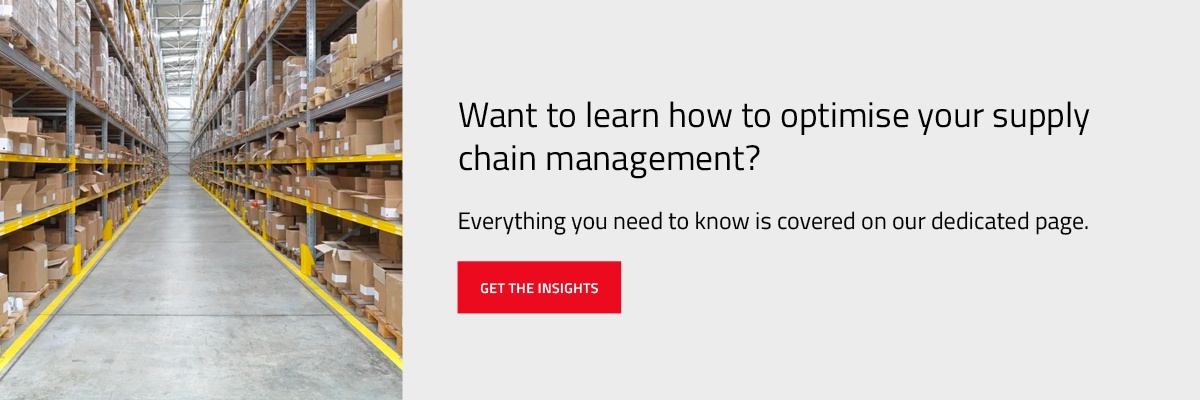Supply chain optimisation is the application of tools and processes to streamline a manufacturing or production operation.
There are certain steps your business should follow when optimising its supply chain. By doing so, you can reap many benefits. This article will explain these steps and the benefits of supply chain optimisation.
- What are the stages of supply chain optimisation?
- How can supply chain optimisation benefit your business?
What are the stages of supply chain optimisation?
Supply chains are made up of different components. These include warehouses, distribution, suppliers and customers.
Every component needs to be carefully considered when optimising your supply chain. Therefore, you should start your optimisation process following a phased approach.
This approach will ensure you cover everything in detail and nothing is missed. The three phases that occur within a successful supply chain optimisation process include:
Supply chain design.
The first stage of supply chain optimisation involves structuring the different components to identify the right balance.
By doing this, your business can spot inefficiencies and potential risks in the supply chain. Once you have done this, you can move on to the next phase of the optimisation process.
This involves implementing plans to improve efficiency, increase customer satisfaction and achieve other long-term strategic objectives.
Supply chain planning.
Now you have a clear picture of what your overall supply chain looks like and which components are performing better than others, you should create a strategic supply chain deployment plan.
At this stage, you should factor in elements such as the design and location of your warehouse to determine how to leverage it for optimal performance.
Supply management is crucial too. This involves sourcing and procuring trusted suppliers who can add value to your operation.
There are other elements to consider in supply chain planning. These include:
- Demand planning and management.
- Production management.
- Your pricing strategy.
- Inventory management.
- Integrated business planning.
Once you have mapped out the design of your supply chain and a plan that will enable you to begin optimising the necessary components, it is time to put your plan into action. This happens during the execution stage.
Supply chain execution.
The final stage of the supply chain optimisation process involves managing the processes and activities to ensure the completion of plans.
There are certain solutions that can support your business at this stage, including a Warehouse Management System (WMS).
A WMS can help you manage many of the different tasks involved during the execution stage. Some of these include:
- Managing your inventory.
- Packing and shipping your products.
- Optimising labour management.
- Allocating your orders.
- Handling materials effectively.
Ready to learn more about the value of supply chain optimisation and how it can contribute to business profitability? Download a copy of our playbook to get started.
Start improving your supply chain and generating more revenue.
Our playbook outlines the most impactful strategies your business can implement to make effective changes to your supply chain and achieve your goals.
How can supply chain optimisation benefit your business?
Optimising your supply chain is not something that happens overnight. It involves a lot of decision-making and, in most cases, embracing change.
For some, change can seem daunting. Your supply chain is already generating results and you are working towards achieving your goals.
However, a well-optimised supply chain can offer a range of benefits. These include:
Meeting customer demands.
Customer demands change frequently. Therefore, to meet these demands, supply chains must be innovative.
By optimising different components of your supply chain, you can incorporate solutions such as automation to stay competitive.
Improved efficiency.
At the supply chain design stage, you should remove any inefficient processes causing issues such as bottlenecks, errors and breakages.
This will simplify your entire operation, creating a more flexible workforce while providing end-to-end transparency.
Better supply chain collaboration.
Not only will optimising your supply chain improve the performance of your business, but it will also provide an opportunity for better collaboration with key stakeholders.
An optimally managed supply chain allows you to share real-time information with your trading partners, including suppliers and customers.
This enables greater opportunities to make better decisions and mitigate risks such as late orders or supply shortages.
Cost reductions and increased profitability.
An optimised supply chain should focus on cutting operating costs. These costs are made up of investment, transportation, procurement, production and procurement costs.
In turn, this should positively impact you and make you more profitable — the end goal we are all trying to achieve.
If you are interested in learning more about supply chain profitability and the strategies your business needs to embrace to make it an achievable goal, we have just the resource for you.
Improve revenue and begin managing your supply chain more effectively with our playbook.
From analysing your supply chain to automating your processes, there are strategies your business should incorporate to improve supply chain profitability.
Find out more about these strategies and how to get started on your journey to optimising your supply chain by downloading the supply chain profitability playbook.


